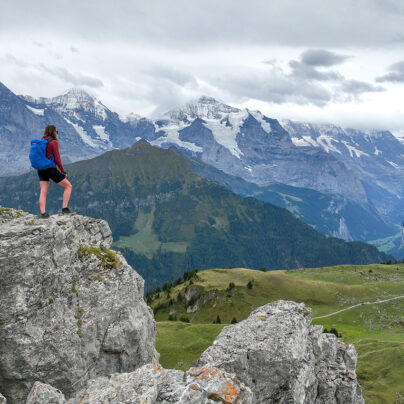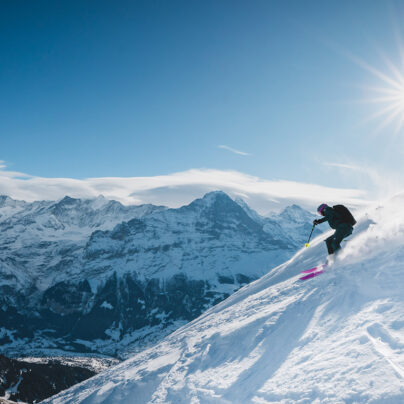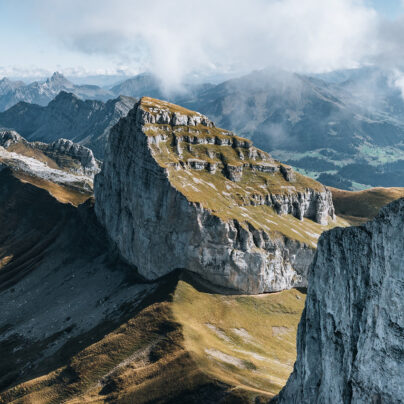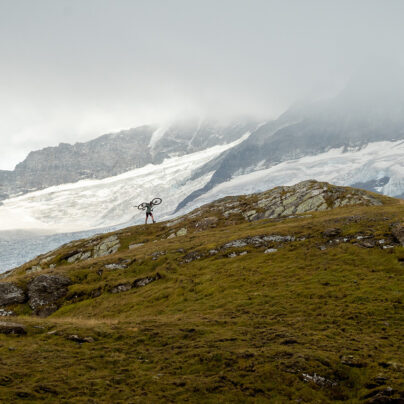Last Summer Light: Fjord til Fjell
Written by James Forrest // Photography by Tom Kahler
Produced in Partnership with Ford Europe
I gaze up at the plunging 1,000m cliff, mesmerised. It looks like Thor’s hammer has smashed the mountain in half, exposing its rocky innards and revealing a sheer wall of immense grandeur with a fang-like rim.
Like a cresting wave of naked rock rising out of the valley – simultaneously majestic and foreboding, magisterial and domineering – the Troll Wall is a Norwegian masterpiece. It is Europe’s tallest cliff face: an impenetrable wall of gneiss, topped with an army of monstrous deformed turrets and towers of rock. These spires, according to local folklore, are the trolls who didn’t make it home before sunrise and turned to stone, solidified for eternity to guard over the soaring Troll Wall. I gaze up at the plunging 1,000m cliff, mesmerised. It looks like Thor’s hammer has smashed the mountain in half, exposing its rocky innards and revealing a sheer wall of immense grandeur with a fang-like rim. ‘I can’t wait to peer over the edge tomorrow,’ I say to my girlfriend Nic, feeling jelly-legged just thinking about it. ‘It’ll be the perfect ending to our sea-to-summit adventure,’ she replies.
We’re in Norway on a camper-van road trip with a loose plan: to journey from the ocean to the mountains, or from fjord til fjell, as the locals would put it, and to make the most of the long, light evenings in Scandinavia before winter arrives. In a whistle-stop, five-day tour, we want to see the full breadth of Norway’s beauty from shore to peak, cramming in as much biking, kayaking and hiking as we can. It’s a concept Nic and I dreamt up in the Scottish Highlands. We’ve spent the spring and summer climbing all 282 Munros in Scotland – a crazy challenge that has, at times, been so exhausting, so rainy, so mentally draining that our love for the mountains has been rocked. We hope that a journey through Norway will reignite our love for friluftsliv. Translated literally as ‘free-air life’, or in other words ‘open-air living’, it is a central tenet of Scandinavian culture, a belief in the spiritual and physical well-being that comes from spending time outdoors in beautiful, remote locations. From fishing and kayaking to hiking and skiing, the friluftsliv lifestyle is what makes Norwegians one of the happiest peoples across the globe.
As we watch wispy clouds swirl atmospherically around the Troll Wall’s pinnacles, we can’t yet know that our dreams of standing atop the wall will actually be dashed by impending storms and low cloud the following day. All that drama, however, lies ahead – and from the comfort of our orange Ford Nugget camper van we wallow in glorious ignorance. ‘I feel friluftsliv-y,’ I say to Nic, as an almost blue-black darkness descends across the Romsdalen valley. ‘I’m pretty sure that’s not a word,’ she says with a laugh, ‘but I feel the same.’



Rewind three days and, true to our mission, we kick off our sea-to-summit expedition from the Norwegian Sea. After a flight to Ålesund in the north-west of Norway, we drive to the island of Gødoya, head down a rough track, park up our camper next to sand dunes, and watch in awe as the setting sun paints a swirling canvas across the dusk sky. Ethereal rays of light penetrate the clouds intermittently, while the sea rages with a palpable menace, its never-ending waves crashing into dark boulders and cliffs, sending white explosions of spray water high into the air. It’s a dramatic start – and we wouldn’t have wanted it any other way.
We wake beachside, rested from a night in our camper’s cosy roof bed, and spend a lazy morning sipping on freshly brewed coffee and watching oystercatchers pottering busily around the rock pools, as if rushed with their daily chores. ‘Where are we exactly?’ I ask Nic, conscious of our impulsive, last-minute decision to start our adventure at this particular beach. ‘I have no idea,’ she replies, chuckling. ‘But I do know that it feels awesome to wake up somewhere random. We’re going with the flow and embracing the unpredictability of the open road – and I love it.’
As we hit that open road later that morning, serendipity – stumbling upon interest and beauty by chance – remains a theme of our travels. Is it fate, a higher power, guiding our quest for friluftsliv? Or perhaps simply the law of averages; because Norway is so blessed with striking landscapes it’s difficult to avoid them? Either way, our lack of planning doesn’t result in a lack of memorable experiences. On the Atlantic Ocean Road, a scenic drive over curved island-hopping bridges, we stumble across an abandoned fjord-side boathouse – a charming structure with flaking red paint, rickety stilts and discarded buoys and lines of rope, its own seaweed-strewn beach, and views across green hills and blue waters. To other eyes it might look worn and dilapidated. To us it is an idyllic symbol of Norwegian culture – close to nature and at one with the outdoors. We stop for lunch, our legs dangling from the wooden jetty, and feel happy with another off-the-cuff choice.
Feeling like we’re on a run of good luck, we roll the dice again, and drive to a nearby ferry port. We check the timetable pinned to a notice board. ‘There’s one in ten minutes,’ I say, relieved. ‘Perfect,’ Nic says as we join the queue. An hour later, we’re on the island of Sekken, parked up in a muddy lay-by next to a forestry track, loading our gravel bikes off our camper van’s robotic-arm-like cycle rack. A glance at Norgeskart – a mapping app on my phone much like the UK’s Ordnance Survey – gives me a rough idea of a route, but we don’t over plan it.
Thick tyres crunch on the dirt track; gears clunk up and down, responding to the demands of our twitching thumbs; and our lungs heave as we battle against undulating terrain. We are going nowhere in particular – but it doesn’t matter.





We turn left and cycle side by side, weaving through lush evergreen woodland. Thick tyres crunch on the dirt track; gears clunk up and down, responding to the demands of our twitching thumbs; and our lungs heave as we battle against undulating terrain. We are going nowhere in particular – but it doesn’t matter. It feels as if we’re uncovering a forgotten side of rural Norway, an authentic part of the country far from the tourist trail. Rows of tree trunks blur as we race faster and faster, and we pass a succession of quaint hillside farms and colourful chalets. I’m about to suggest we turn around when a clearing in the forest appears. We lug the bikes over our shoulders, tramp over heather and mounds of wet moss, and emerge onto a rocky platform with panoramas across distant hills and an isle-dotted fjord. We were going somewhere in particular after all – we just hadn’t realised it at the beginning.
***
Time stands still. Real life slides away, joyously out of reach – and all that is left is pure and tranquil. There is nothing in this world but blue-green fjords and soaring peaks. I’m in the space between, both physically and emotionally.
‘Follow me,’ Nic says the following day, as she paddles out of the turquoise shallows of the U-shaped bay for the deeper blues of the fjord’s centre. Ten minutes later we pause, exchanging no words but we intuitively know what the plan is: to rest our paddles and immerse ourselves in the silence of the fjord. I feel connected to nature. My kayak bobs this way and that, dancing in harmony with the gentle flow of the fjord; a whisper of wind blows, filling my lungs with the awakening rush of fresh air; and a transparent, umbrella-shaped jellyfish with trailing tentacles pulsates next to my vessel, as if intrigued by the strange intruder into its territory.
Time stands still. Real life slides away, joyously out of reach – and all that is left is pure and tranquil. There is nothing in this world but blue-green fjords and soaring peaks. I’m in the space between, both physically and emotionally. My kayak glides over translucent waters, floating in nirvana between the seas and the mountains, and my daydreaming mind drifts to a blissful halfway house, a mental sanctuary between reality and make-believe. Everyday worries and anxieties melt away. I wonder whether they’ve been banished forever to the encircling mountain crags, or if they’ve sunk to the bottom of the fathomless fjord.
From the seat of my kayak, I raise my eyes to the surrounding mountains. Towering peaks enclose the fjord, rising impossibly out of the water. Thick, green forest cloaks their lower slopes; crags shatter their rocky uppers; and white streams pierce their domineering bulk, flowing endlessly into the waters below. But it isn’t the majestic mountains that capture my attention. I’m mesmerised by the simplest of things: the ripple of concentric circles created by a single drip falling into the still water, and the diminutive whirlpool formed by my paddle. It might just be cold, hard physics in action, but it feels like art.
The long, light days of late summer give us extra hours for adventuring – and we don’t waste them, conscious that the short days and long nights of our British winter are just around the corner. At times we paddle hard, exploring a shoreline of beguiling inlets and beaches; at others we rest and float, calmly relenting to the pull of the tide, as if attempting to mirror the rhythmic swaying of the seaweed forest below us. The relaxation spirals me into a daydream. I feel as if I could drift away into eternity, destined to spend the rest of my days floating here in this heaven.
But, eventually, the rumble of my stomach – and the arrival of dusk – jerks me back to the here and now. We paddle back to land, pack away our gear and start preparing a sweet potato curry for dinner. Half an hour later, as the fjord gently laps the shore, silhouetted mountains fill the darkening skyline and our food bubbles appetisingly over a smoky open fire. Conscious to avoid leaving a trace on the landscape, I had carefully lit our fire below the low-tide line. But, ironically, Norway’s landscape does not obey by the same principles. It leaves an imprint on Nic and me, re-opening our eyes to the joys of open-air living.





The following day we drive up Trollstigen, Norway’s most famous road – a serpentine mountain pass with no fewer than 11 dizzying switchbacks. In the morning we want to stand atop the Troll Wall, the legendary cliff face with an uninterrupted, sheer drop of about 1,100m. Despite being a shrine for climbers, base jumpers (until the practice was banned in 1986), and other adrenaline junkies, it is not only for the hardcore – it is possible to simply walk to the peak over rugged but non-technical terrain from the south-west. It is a rousing, if somewhat spine-chilling, prospect.
Every twist and turn up Trollstigen takes us past another plunging waterfall or soaring crag, each a poignant reminder of the dichotomy of Mother Nature: formidable, treacherous power combined with entrancing beauty. Today the former appears to be in charge. Moody clouds swirl, a strong wind blows, and snow appears to be falling over the high peaks, dusting their tops in a cloak of white that looks elegant and perilous in equal measure. We stop overnight to see if the weather will pass, but in the morning the storm still looms. We’re forced to make a tough decision. With heavy hearts, we ditch our plan to stand atop the Troll Wall out of fear the going will be too hostile and unsafe in these conditions. Our dream to peer over Europe’s tallest cliff is over – but there is no way we are going to fail to complete our mission to journey from fjord til fjell. After some frantic studying of our map, a new plan is hatched.
Wrapped from head to toe in Gore-Tex, we head out from the visitor centre at the top of the road and climb over rocky terrain with a new peak in our sights. It is a nameless summit with a relatively lowly stature. At just 1,210m high, it’s a baby compared to the towering summits all around; a minor dwarfed by snow-capped behemoths. But it still proves to be a fitting and challenging end to our journey. A rough path fades away and we find ourselves scrambling over jumbled boulders, our bare hands gripping cold rock and our boots crunching on snow-speckled scree, until we finally emerge at a cairned rocky knoll. It is the perfect climax – an exposed little summit topped with a slab of rock, a natural platform for gazing over the mountains. The views stir our souls: sheer cliffs, crescendoing with spikes of rock and blade-like crests, and sweeping ridgelines that rise to piercing summits. A trio of peaks dominate the skyline. I check my map to learn their names: Kongen (‘the King’), Dronninga (‘the Queen’) and Bispen (‘the Bishop’) – fitting for such a regal landscape.
I place a small stone on the cairn atop the unnamed peak. ‘We should name this summit,’ I say to Nic, feeling that we can claim ownership of our own little piece of Norway. ‘Any ideas?’ she replies. ‘Mount Friluftsliv,’ I say confidently as we turn around and begin to descend.
The views stir our souls: sheer cliffs, crescendoing with spikes of rock and blade-like crests, and sweeping ridgelines that rise to piercing summits.



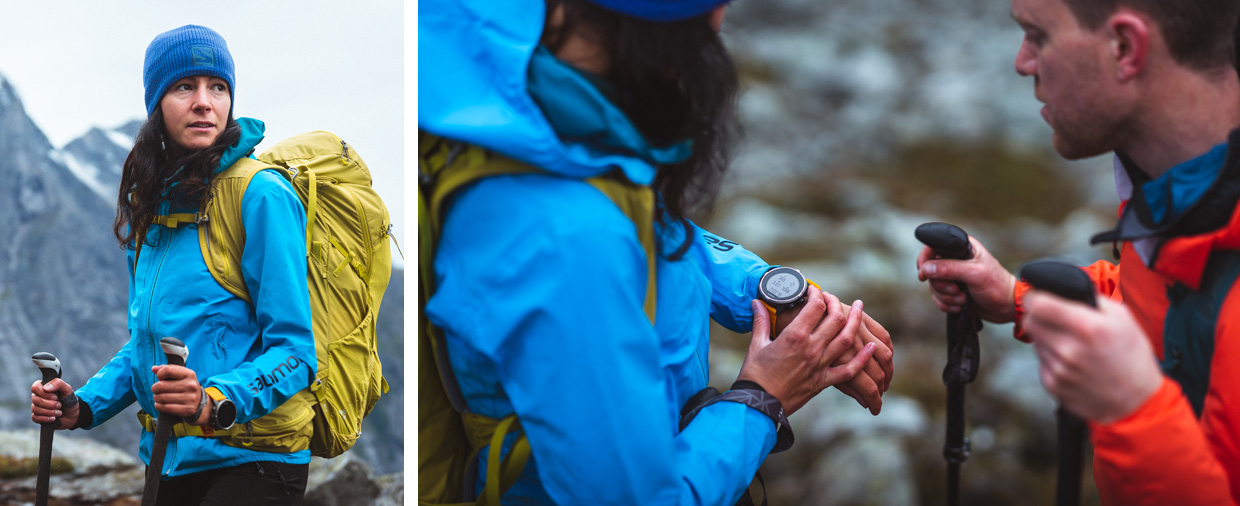

Written by James Forrest // With Nic Hardy
Photography by Tom Kahler // Film by Gee Milner // Thanks to Mason Cycles
Produced in partnership with Ford Europe // @fordeurope





